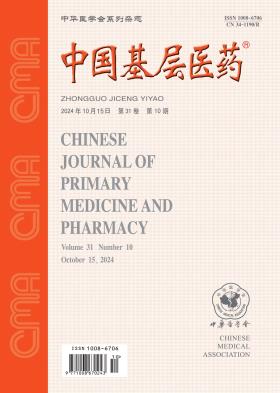Clinical study on the safety of dexmedetomidine withdrawal in patients undergoing mechanical ventilation after cardiopulmonary bypass in ICU
引用次数: 0
Abstract
Objective To compare the safety of dexmedetomidine and midazolam in weaning mechanical ventilation patients after cardiopulmonary bypass (CPB) in ICU. Methods From August 2016 to December 2018, 51 patients admitted to the People's Hospital of Jinhua for mechanical ventilation after ICU CPB cardiac surgery were randomly divided into dexmedetomidine group and midazolam group according to the numerical table method.During mechanical ventilation, dexmedetomidine was used to sedate the study group(26 cases), and midazolam was used in the control group (25 cases). The total time of mechanical ventilation, CPOT score, ICDSC score, incidence of sinus bradycardia during mechanical ventilation were counted, and the anterograde amnesia was observed after extubation.The safety and related factors of drug withdrawal in patients undergoing mechanical ventilation after CPB surgery of two different sedations were compared and evaluated. Results Statistical analysis showed that the CPOT score of the dexmedetomidine group was (1.04±0.45)points, which was significantly lower than that of the midazolam group[(2.24±0.83)points], the difference was statistically significant between the two groups(t=-6.40, P 0.05). The total time of mechanical ventilation was (29.71±17.96)h in the dexmedetomidine group and (26.13±20.02)h in the midazolam group, there was no statistically significant difference between the two groups(t=0.67, P>0.05). During mechanical ventilation sedation, the dexmedetomidine group had more bradycardia, the difference was statistically significant(χ2=11.96, P<0.01). There was no anterograde amnesia in the dexmedetomidine group, but all of the patients in the midazolam group had anterograde amnesia. Conclusion Compared with the midazolam group, the CPOT score was lower in the dexmedetomidine sedation group with the same SAS score of 4(superficial sedation), which in line with the principles of " deep analgesia, shallow sedation". Although bradycardia occurs during the use of drugs, it can recover spontaneously after withdrawal and is safe to use. Key words: Extracorporeal circulation; Cardiac surgical procedures; Respiration, artificial; Bradycardia; Dexmedetomidine; Midazolam右美托咪定停药对ICU体外循环后机械通气患者安全性的临床研究
目的比较右美托咪定与咪达唑仑在ICU体外循环(CPB)术后脱机机械通气患者中的安全性。方法选取2016年8月至2018年12月金华市人民医院ICU CPB心脏手术后机械通气患者51例,按数值表法随机分为右美托咪定组和咪达唑仑组。在机械通气期间,研究组(26例)采用右美托咪定镇静,对照组(25例)采用咪达唑仑镇静。计算机械通气总时间、CPOT评分、ICDSC评分、机械通气期间窦性心动过缓发生率,拔管后观察顺行性遗忘。比较和评价两种镇静方式下CPB术后机械通气患者停药的安全性及相关因素。结果统计学分析显示,右美托咪定组CPOT评分为(1.04±0.45)分,显著低于咪达唑仑组[(2.24±0.83)分],两组比较差异有统计学意义(t=-6.40, P 0.05)。右美托咪定组机械通气总时间为(29.71±17.96)h,咪达唑仑组为(26.13±20.02)h,两组比较差异无统计学意义(t=0.67, P < 0.05)。机械通气镇静期间,右美托咪定组心动过缓发生率较高,差异有统计学意义(χ2=11.96, P<0.01)。右美托咪定组患者无顺行性遗忘,咪达唑仑组患者均有顺行性遗忘。结论与咪达唑仑组相比,右美托咪定镇静组CPOT评分较低,SAS评分均为4分(表浅镇静),符合“深镇痛,浅镇静”的原则。虽然在用药过程中会发生心动过缓,但停药后可自行恢复,使用安全。关键词:体外循环;心脏外科手术;人工呼吸;心动过缓;Dexmedetomidine;咪达唑仑
本文章由计算机程序翻译,如有差异,请以英文原文为准。
求助全文
约1分钟内获得全文
求助全文
来源期刊
CiteScore
0.10
自引率
0.00%
发文量
32251
期刊介绍:
Since its inception, the journal "Chinese Primary Medicine" has adhered to the development strategy of "based in China, serving the grassroots, and facing the world" as its publishing concept, reporting a large amount of the latest medical information at home and abroad, prospering the academic field of primary medicine, and is praised by readers as a medical encyclopedia that updates knowledge. It is a core journal in China's medical and health field, and its influence index (CI) ranks Q2 in China's academic journals in 2022. It was included in the American Chemical Abstracts in 2008, the World Health Organization Western Pacific Regional Medical Index (WPRIM) in 2009, and the Japan Science and Technology Agency Database (JST) and Scopus Database in 2018, and was included in the Wanfang Data-China Digital Journal Group and the China Academic Journal Comprehensive Evaluation Database.

 求助内容:
求助内容: 应助结果提醒方式:
应助结果提醒方式:


